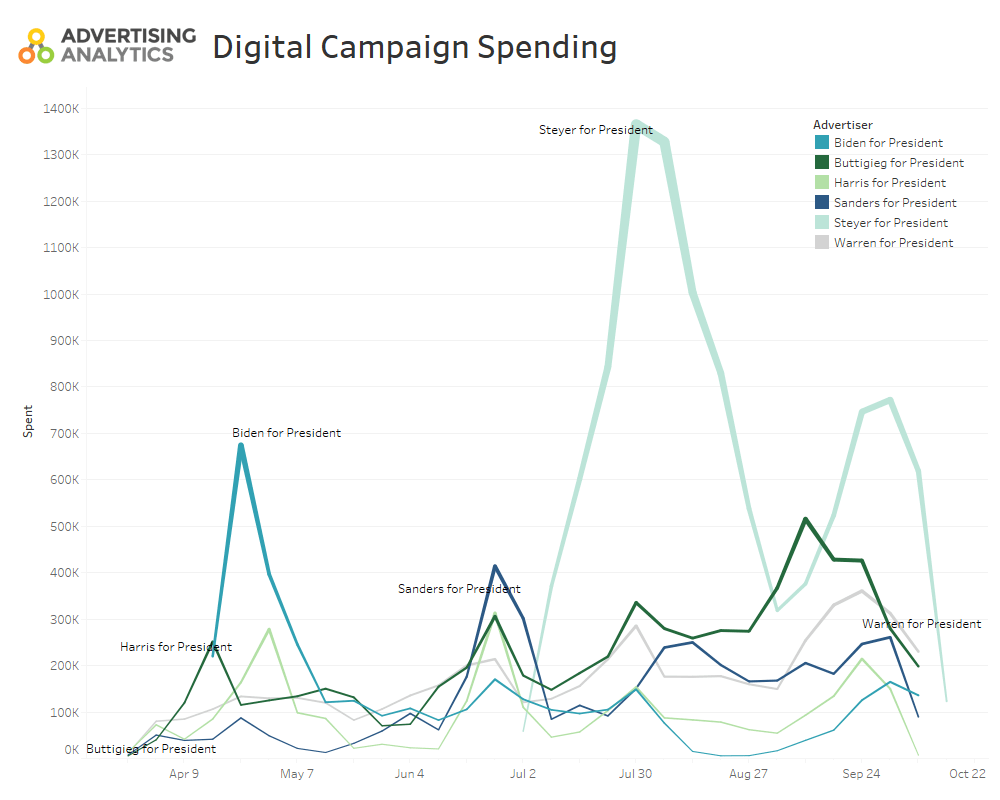Political spending is increasingly moving onto digital platforms. In 2019, nearly 30% of all the spending that [AdImpact] has tracked has occurred on Facebook or Google. A candidate’s digital spending patterns can indicate the health of his or her campaign, and with recent movement in polling numbers, we thought we’d take a look at how the Biden campaign is spending on Facebook and Google.
Biden’s Digital Strategy
Joe Biden clings to a polling lead of about 5 points, according to Real Clear Politics, but it increasingly appears that he is heading towards a resource deficit that will be difficult to overcome. His weak fundraising numbers have drawn attention, especially as his direct rivals raise impressive sums. Much of this fundraising has occurred on digital platforms like Facebook and Google. This type of advertising creates a sort of echo chamber where the candidate spends online to draw in donors, reaps the rewards of this fundraising, and is then able to spend more money on political advertising and campaigning. So far, Democratic presidential candidates have spent $58M on Facebook and Google in 2019. Of this, Biden makes up only 6% of the spending at $3.6M, far behind what one might expect given his strong polling numbers. Since this type of direct response advertising allows candidates to build strong lists that the campaign can tap for more donations, Biden’s low numbers should concern the campaign. For perspective, Pete Buttigieg and Elizabeth Warren have outspent Biden on digital advertising by nearly 100%, raising the question of what their lists must look like compared to the former Vice President’s.

Biden came out of the gates strong, running nearly $700k of digital advertisements his first week in the race. But after that explosive week he trailed off significantly. Biden’s direct competitors have nearly all outspent him every week since. His digital spending numbers have recently picked up, but so have those of his competitors, leaving Biden trailing behind many of the other candidates. Buttigieg and Warren both recently made major digital investments and have reaped the financial rewards. They raised the second and third most dollars in Q3 of anyone in the field, trailing only Bernie Sanders who has the advantage of a massive list from the 2016 cycle. Biden ranks a fairly distant 4th in dollars raised (not counting self-funded Tom Steyer) and is closer in fundraising success to Andrew Yang than Warren. This is a surprising place for Biden to be as the candidate with frontrunner status.
This resource disparity is already apparent is television prebookings for early primary states in 2020. Warren and Biden have each booked in the first four states: Iowa, New Hampshire, South Carolina, and Nevada. Warren has booked $6.9M, compared to Biden’s $3.4M. Warren has an advantage of more than $1M in booked money in Iowa, New Hampshire, and Nevada. The only state in which Biden has an advantage is South Carolina, one of the former VP’s strongest states.
While there is more to campaigning than paid expenditures, the ability to put a message in front of voters is crucial, especially in early states where a disappointing performance can damage a campaign’s momentum. In this case, the Biden campaign’s lack of resources is a starkly apparent weakness, particularly compared to his rivals. Buttigieg, Warren, and Sanders all have the resources to blanket early states with paid advertising, while Biden has yet to display any major monetary advantage.
The Biden campaign’s spending and fundraising trends are perhaps more concerning than the topline deficiencies. Its digital expenditures by week and fundraising numbers by quarter have declined in tandem. Biden’s digital spending spiked at $700K when he first announced but has remained well below the $200K mark each week since. Buttigieg and Warren, by contrast, have been two of the top five digital advertisers for the last five weeks. Additionally, p-Biden was the second highest fundraiser in Q2 at $22M, but fell all the way to 4th in Q3 with $15.7M raised. Buttigieg and Warren were in the 4th and 5th spots for Q1 with less than $7M raised each (and without all candidates announced) and rose to $19M in fundraising during each of the next two quarters.
Biden’s name recognition has carried him in the polls, but other candidates have crept up behind him, in part because of strong digital advertising and fundraising efforts. Digital fundraising alone does not account for a candidate’s quarterly haul, but it is a fundamentally important way to connect with voters, drive a message, and pull in donations. Biden’s low digital spending numbers mean he’s already at a disadvantage, and this appears to be translating to both fundraising numbers and traditional television prebookings in 2020. What this means for the campaign remains to be seen, but in an election fight that is playing out online, Biden has work to do to catch up with his opponents and their every expanding reach.



